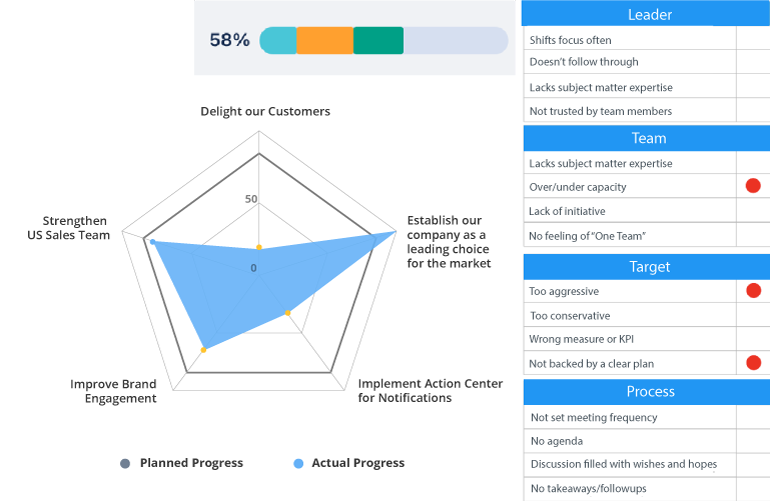Knowing the potential reasons behind unbalanced progress can be helpful in identifying issues that are holding your business back.
In this article, we’re going to give you a framework to analyze situations that exhibit unbalanced progress, using the potential causes we discussed in 16 Reasons Your OKR Progress is Unbalanced.
Teamwork is the ability to work together toward a common vision. The ability to direct individual accomplishments toward organizational objectives. It is the fuel that allows common people to attain uncommon results.
In the following example, we’ve flagged a few potential problems for a given situation. While there could be a myriad of issues lurking beneath unbalanced progress, and you should always investigate the red flags you see, you can use this case study as a starting point to understand how these issues can play out.
Unbalanced Progress: Team and Target

In this example, we have unbalanced progress on a 5-OKR radar chart for a company’s corporate-level OKRs. These are the top priorities for a company in the given quarter.
This obviously meets the rule of 5 for OKRs, but as we can see from the black outline of the pentagon, progress should be a lot further along in some cases, and is too far along in others. Why the imbalance? Let’s take a closer look.
1. Over/Under Capacity
The second OKR at this level is “Establish our company as a leading choice for the market”. This OKR has already been completed, even though there are a few weeks left in the quarter. When contrasted against OKRs such as the first one, “Delight Our Customers,” we notice that something isn’t quite right.
The problem could be with over or under capacity. With “Establish our company as a leading choice for the market,” it seems that the team blazed through the OKR with ease. While this could be a good thing, it might be a signal that the company overcommitted resources and team members for the success of this objective. The excess team members could have been helping out with initiatives that were lagging behind, and wasted resources are an issue that can snowball in no time.
Meanwhile, the initiative for “Delight Our Customers” fell completely behind. In the effort to become a leader in the market with outbound initiatives, the team didn’t commit to the customers they already had, leaving this goal at under capacity.
2. Not Backed by a Clear Plan
The next problems could come in the form of target issues. Take a look at the OKR to “Implement an Action Center for Notifications”. This is an objective that would require key results that follow the MECE principle– of being mutually exclusive and collectively exhaustive. If this objective isn’t backed by a clearly-defined plan that covers all the necessary aspects of rolling out an action center for notifications, then the objective simply will not be fulfilled.
This is a problem that dates back to the planning stage of the OKR cycle. Before this OKR even began making progress, it was doomed to fail. Ensure you have all the tools you need to write amazing OKRs, and dedicate more time and care to planning out your OKRs in the next quarter.
3. Too Aggressive
The last potential reason behind this radar chart’s unbalanced progress is another issue related to targets. While OKRs encourage you to be ambitious and reach for the stars, leaders need to find realistic common ground with their team to come up with a target number that is a stretch, but not an impossibility.
As you can see with the fourth OKR on this chart, “Improve Brand Engagement,” progress is moving, but it still has an “At Risk” status and is failing to meet expectations, or come close enough to still be “On Track”. This is an issue that also begins at the Planning stage of the PEEL cycle– but it also is one that seemingly went unnoticed throughout the entire quarter.
In order to have the most success with OKRs, you need to commit to weekly or biweekly meetings to check in on team progress. This is a designated time where teams can touch base on progress, problems, and plans, and make a game plan to get back on track if they have strayed off course.
Ready to start your OKR Journey for FREE?
Final Thoughts
If you have properly set your OKRs and rolled out your program, unbalanced progress should not be a prevalent issue during your quarter. If it is, you need to take a close look at your OKRs and determine the root causes behind the imbalances on your radar chart.
While unbalanced OKR progress can feel discouraging to see, the first step to resolving the issue is identifying it. Once you’re able to pinpoint what’s going wrong, you can make the right moves to get back on track! Many times, getting back to the OKR basics can help you recalibrate your team and resolve the issues you are facing in your organization.
Using case studies to help demonstrate what potential issues will look like in real life can be useful for leaders and team members alike.
For more examples of unbalanced progress, take a look at our additional case study articles:
- Unbalanced Progress: What’s Going Wrong?: Take a look at what Profit.co’s radar chart, what you can do during your planning process to help prevent unbalanced progress, and what it means for your organization in this first article in the Unbalanced Progress series.
- 16 Reasons your OKR Progress is Unbalanced: In this article, share the top reasons your OKR progress might be unbalanced and the causes hiding behind these effects.
- Solving Unbalanced Progress: Marketing Department Imbalance: This case study examines six OKRs at the marketing level and the issues that are causing an imbalance of OKR progress, as shown by the Profit.co radar chart.
- Solving Unbalanced Progress: Sales Department Imbalance: In this final case study for the Unbalanced Progress series, we’ll take a look at a sales department that is seemingly doing everything right, but is still facing unbalanced progress.

